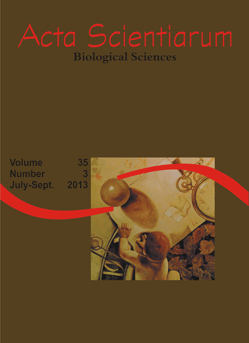<b>Biochemical and cellularchanges in <i>Oreochromis niloticus</i> related to the water pollution of a degraded river</b> - doi: 10.4025/actascibiolsci.v35i3.13207
Resumo
The effects of polluted water at three sites in the Marinho River, Brazil, on Oreochromis niloticus (Nile tilápia) were investigated using histological, hematological and biochemical approaches. Fish exposed to the impacted water demonstrated that histological changes in gills were accompanied by nuclear and micronuclei abnormalities in cells. The activity of liver and plasma biomarkers (alkaline phosphatase (ALP), acid phosphatase (ACP), alanine aminotransferase (ALT), aspartate aminotransferase (AST) and liver glutathione S-transferase (GST)) showed an expressive change due to the. The results were also correlated with the highest levels of Cu+2, Zn+2 and Mn+2 in the water. The data of this study evidenced the importance of using a set of biomarkers to quantify pollution in lentic ecosystems. Additionally, histological analyses of gills and erythrocytes have proven to be an important instrument for signaling the impact of pollutants in rivers.
Downloads
DECLARAÇÃO DE ORIGINALIDADE E DIREITOS AUTORAIS
Declaro que o presente artigo é original, não tendo sido submetido à publicação em qualquer outro periódico nacional ou internacional, quer seja em parte ou em sua totalidade.
Os direitos autorais pertencem exclusivamente aos autores. Os direitos de licenciamento utilizados pelo periódico é a licença Creative Commons Attribution 4.0 (CC BY 4.0): são permitidos o compartilhamento (cópia e distribuição do material em qualqer meio ou formato) e adaptação (remix, transformação e criação de material a partir do conteúdo assim licenciado para quaisquer fins, inclusive comerciais.
Recomenda-se a leitura desse link para maiores informações sobre o tema: fornecimento de créditos e referências de forma correta, entre outros detalhes cruciais para uso adequado do material licenciado.












1.png)




3.png)













